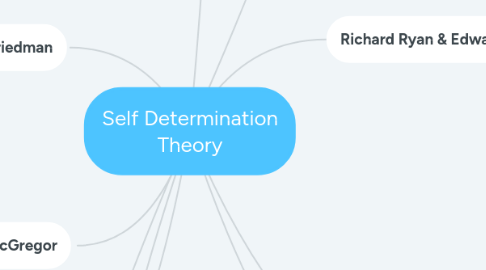
1. Universal human needs
1.1. Competence
1.2. Autonomy
1.3. Relatedness
2. Not tendencies
3. If universal human needs are met, behaviors include:
3.1. Happy
3.2. Productive
3.3. Motivated
4. ..."using rewards to motivate, that's when they're most demotivated."
5. Meyer Friedman
5.1. Type A
5.1.1. Express "hurry-sickness", more prone to heart disease
5.1.2. Be more like Type B
5.2. Type B
5.2.1. Drive gives security, confidence and steadiness
5.2.2. Healthier
6. Pink
6.1. Type I
6.1.1. Fueled by intrinsic
6.1.2. Motivation 3.0
6.1.3. The goal
6.2. Type X
6.2.1. Fueled by extrinsic
6.2.2. Motivation 2.0
6.2.3. Be more like Type I
7. Douglas McGregor
7.1. Type X
7.1.1. Employees hate and avoid work
7.1.2. Traditional and false
7.2. Type Y
7.2.1. Interested in work as "as natural as play or rest"
7.2.2. Seek responsibility and innate
8. Perceived Competence & Autonomy
8.1. Develop intrinsic motivation
9. Autonomy & Relatedness or Security
9.1. Children more exploratory
10. Richard Ryan & Edward Deci
10.1. Facilitating intrinsic motivation
10.1.1. Researchers include Carol Dweck, growth mindset
10.2. Cognitive Evaluation Theory, how intrinsic motivation supported:
10.2.1. Social-contextual events
10.2.2. Feeling of competence during action
10.2.3. Optimal challenges
10.2.4. Effectance-promoting feedback
10.2.5. Evaluations promoting dignity
10.2.6. Not threats
10.2.7. Not deadlines
10.2.8. Not directives
10.2.9. Not pressured evaluations
10.2.10. No imposed goals
10.2.11. Must hold value
10.2.11.1. Aesthetic
10.2.11.2. Challenging
10.2.11.3. Novel
10.3. Organic Integration Theory, the way to include extrinsic motivation:
10.3.1. Extrinsic can become intrinsic
10.3.2. Internalization
10.3.2.1. Through autonomy
10.3.2.2. Synthesize with own goals and values
10.3.2.3. Socially promote and needed
